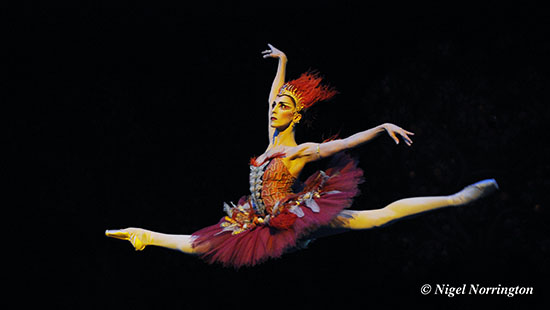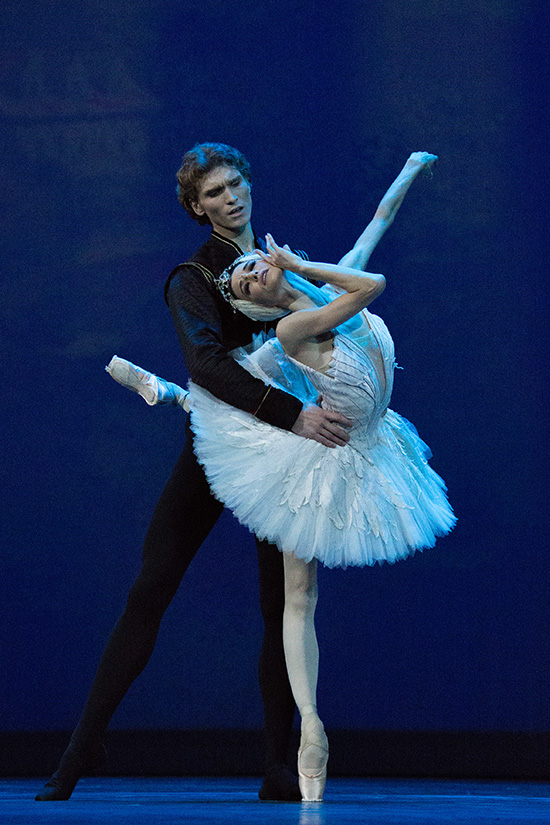by Iratxe de Arantzibia.
People who reside, or rather skip about the foot of the Pyrenees, and who are called Vasques or Vascons. That is how Voltaire described Basques in The Princess of Babylon (1768).
The close relationship between Basques and dance goes a long way back in time. In fact, classical ballet is considered to have been influenced substantially by traditional Basque dance. Ballet is a French creation, and The Royal Academy of Dance, founded in 1661 by Luis XIV, documents 25 Basque ballet dancers in its first years of existence. That is why there are three steps in the academic jargon that show this common root: pas de basque, grand pas de basque and saut de basque.

Itziar Mendizabal was nominated the Dance Oscar for her role in Firebird ©Nigel Norrington
However, it is not until the last two decades of the 20th century that the diaspora of Basque ballet dancers becomes a global phenomenon. The short-lived Ballet de Euskadi (1989-1996) (Basque Ballet) forced dancers who aspired to be professionals locally into exile. Unofficial sources claim there are about sixty Basque dancers working abroad. Still, a process of generational renewal is taking place, and while performers in their 40s are now beginning to retire from the stage, new ones are arising.
There are two names that stand out as best known by the public: Lucia Lacarra (Principal Dancer in the Bavarian State Ballet) and Igor Yebra (Étoile in the Bordeaux National Opera). Regarded as the most prizewinning and acclaimed dancer of her generation, Lucia Lacarra is the only Basque dancer with a dance Oscar, Prix Benois de la Danse (2003), awarded by the Bolshoi Theatre of Moscow. Another landmark in her career was her participation in the New Year Concert in Vienna (2007), conducted by Zubin Mehta, in which she was the first dancer ever to dance The Blue Danube live from the Schönbrunn Palace. The broadcast on the international channel of the ORT had an estimated audience of a hundred million viewers across 60 countries. In addition, she has been awarded the prestigious Prix Nijinsky of Monaco (2002), the Spanish Premio Nacional de Danza (2005) and the “Dance Open” of Saint Petersburg twice (2010 and 2013).

Alicia Amatriain and Friedemann Vogel performing in ‘Black Swan’. ©Stuttgart Ballet
The nomadic nature of a dancer’s career is well represented by Igor Yebra. From Victor Ullate’s Ballet in Madrid he moved on to the Australian Ballet as a guest performer. One of his most memorable performances was in the role of Ivan the Terrible in the State Kremlin Palace in Moscow, which made him the first non-Russian dancer to play the role. His track record includes many other awards such as the Italian “Danza & Danza” (1996), “Léonide Massine” (2003) and “Gialino d`Oro” (2010), among others. Yebra currently dances in the Bordeaux National Opera and collaborates regularly with other ballets such as the Ballet Company of Teatro dell’Opera.
Alicia Amatriain (San Sebastian, 1980, Principal Dancer from the Stuttgart Ballet), and Itziar Mendizabal (Hondarribia, 1981, First Soloist of the Royal Ballet) complete the exceptional foursome that represents Basque ballet abroad. Included in the top 100 world ranking, Amatriain has developed her entire career in Stuttgart, and in recent years she appears often in international circles. She has been awarded the German dance prize “Future” as well as the Italian “Danza & Danza” and “Léonide Massine” (2009). Likewise, Mendizabal is making a mark in the Royal Ballet in London, which is considered one of the best five companies in the world. During her stay in the Leipzig Ballet she was nominated for the dance Oscar, Prix Benois de la Danse (2009), for her performance in The Firebird.
Lucia Lacarra, Igor Yebra, Alicia Amatriain and Itziar Mendizabal are the four best examples of active Basque ballet dancers of the diaspora. In recent years, several great performers have retired from the stage such as: Urtzi Aranburu (Nederlands Dans Theater), Mónica Zamora (Birmingham Royal Ballet), Leire Ortueta (Royal Ballet), Alfonso Martín (Tulsa Ballet); and more recently Asier Uriagereka (Les Ballets de Monte-Carlo). While some inexhaustible dancers like San Martín or Amancio González (The Forsythe Company, Frankfurt) remain active up into their forties, promising new names are making it into the spotlight such as Jon Vallejo (Dresden Semperoper Ballett), Asier Edeso (Les Ballets de Monte-Carlo), Ion Agirretxe (Royal Ballet of Flanders), and the last one to make his debut, Aitor Arrieta (Compañía Nacional de Danza). The generational shift is guaranteed, even though, and contrary to Voltaire’s definition, Basques are people who dance far from the Pyrenees.
 Igor Yebra reaped unprecedented success as the first non-Russian dancer to play Ivan, The Terrible. ©Photo courtesy of Igor Yebra. |
 Lucia Lacarra and Marlon Dino dancing in ‘Swan Lake’ ©M. Logvinov. |
 |
Iratxe de Arantzibia is a Journalist, Dance Critic and Press Manager. |
| @idearantzibia | |
| http://sautdebasque.wordpress.com/ |


Great job! And we still don’t have a proper university for dancers in the Basque Country. That should be the next big project for the Gov, after Musikene and The Basque Culinary Center.